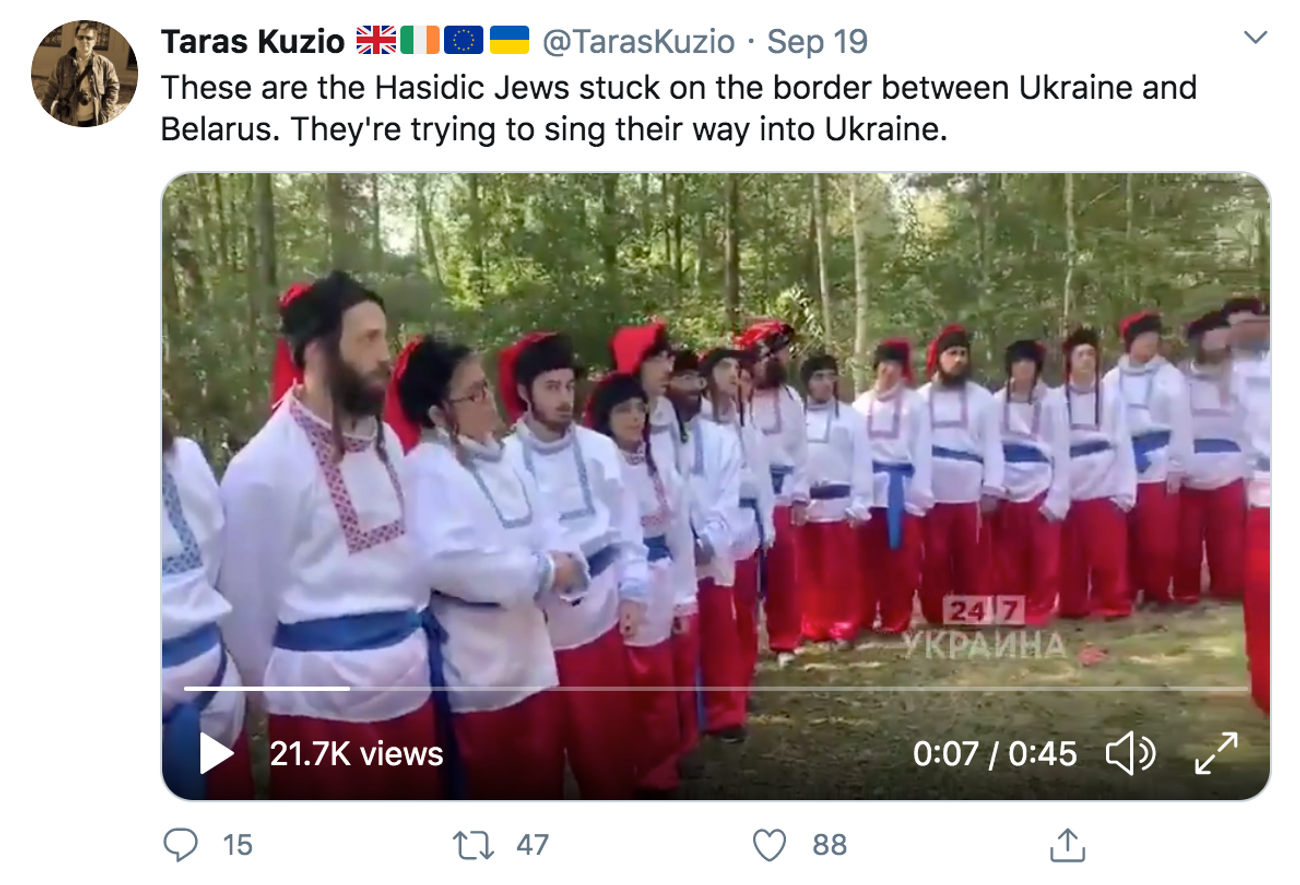3,000 Hasidic Cossacks Congregate on Ukrainian Border
Is Rebbe Nachman playing a practical joke from beyond the grave, or is this Eastern Europe’s version of normal during a pandemic? And who paid for the shirts?




Operating in total haste, the Ukrainian government unexpectedly announced last month that in response to a serious upswing in cases of COVID-19, it would reestablish the most stringent border entry policy in the world. That public health policy has created a new problem for the Eastern European country: A large group of religious Jews prone to bouts of jubilant dancing is now marooned on the Ukrainian border, pleading and demanding entry into the country so they can carry out their annual religious rites.
Ukraine’s entry ban was set to commence for the month from Aug. 28 to Sept. 28, leading some observers to speculate that it was aimed specifically at the religious pilgrims who embark on an annual pilgrimage to the Ukrainian town of Uman and engage in Rosh Hashanah festivities. The anarchic, mystical, dance-filled gathering of tens of thousands of Hasidim is very much akin to the Burning Man festival of the Jewish world. The atmosphere does not leave much room for social distancing, which led Ukrainian authorities to predict that it could become a superspreader event and prompted their intervention.
The destination for the festivities is the tomb of Rabbi Nachman, the founder of the mystically inclined Breslov Hasidic dynasty, which is located halfway between Odessa and Kyiv. The pilgrimage ritual began after his death in 1811 and continued on as a clandestine activity during late Soviet times when all religious observances were banned by the Soviet authorities. It has morphed in recent decades into an annual ritual for thousands of Hasids who arrive mostly from Israel and America but also come from France, the United Kingdom, and the wider post-Soviet world.
Notably, the pilgrimage to Uman has been a source of occasional tension and trouble for many years, with the friction occasionally erupting into local violence that has a way of transforming into diplomatic headaches for all involved. This year, both the Israeli and the Ukrainian governments had pleaded with the Hasidim—to no avail—that they take this plague year off from visiting the tomb of the rabbi. Neither government had particularly wanted the problems which were to follow and the Israeli government engaged in high-level diplomatic negotiations with the Ukrainians regarding the issue.
Last Thursday evening, a truly surreal video appeared on social media as several dozen Hasidim dressed up in traditional Ukrainian folk costumes in order to serenade the Ukrainians into offering them entry. Looking fabulous in billowy white shirts and blue sashes over the bright red trousers of Ukrainian Cossacks, the Hasids performed a shortened version of the Ukrainian national anthem in a rather minor mournful key. One of them strummed a guitar while singing the words of the Ukrainian anthem with a charming, lilting accent. The rendition was surprisingly melancholic and moving. They concluded the song by offering up thanks to Ukraine and to Ukraine’s Jewish President Volodymyr Zelensky personally. “Glory to Ukraine!” they exclaim in unison at the end of the video, with likely no understanding of the historical provenance of the phrase.
With all direct flights to Kyiv canceled, the Hasidim who were determined to make a run at the border needed to do so by arriving in next door Belarus. This required them to decamp in the middle of a revolutionary situation and massive popular protests that followed the falsified Aug. 9 presidential election and ensuing violence between demonstrators and state security forces. Kyiv recently broke off all political and diplomatic relations with Minsk in response to Belarusian President Alexander Lukashenko’s continued accusations that Ukraine meddled in Belarus’ political upheaval and fomented problems at the border between the two nations. Ukrainian officials who were already incensed with Minsk over the accusations now suspected that the Belarusians were also funneling Hasidic mystics to their border in order to cause further problems.
The BBC reported that “the office of Ukraine’s president said Belarus was spreading false hope that the pilgrims could cross. Belarus wants a corridor to be opened for them.” The fact that Ukraine’s President Zelensky is himself of Jewish patrimony has not put him in any rush to assist the religious pilgrims—if anything, Zelensky’s background likely makes him more reluctant to be seen as offering special accommodations to the Hasidic travelers. On Tuesday, President Lukashenko took time away from the existential legitimacy crisis that threatens to topple his 26-year-long dictatorship in order to opine that Ukraine had to provide a “green corridor for pilgrims to arrive in Uman by bus.” Accusations that the Ukrainians were committing human rights violations were proffered without any apparent irony.
A phalanx of Ukrainian border guards resting on their steel shields can be seen manning a checkpoint in front of hundreds of Orthodox men in videos published from the border. Some of the Hasidim at the border wait pensively, some pray, and others dance raucously.
Throughout the month of August, Minsk began to fill up with Orthodox Jews preparing to make the illegal crossing into Ukraine. The Belarusian authorities could be seen brusquely turning Hasidim away at the check-in counter at the Minsk airport all three times that I found myself there in the last month. On at least one occasion, Tablet’s correspondent took pity on them and intervened personally to issue the necessary invitation letters to pilgrims on letterhead from my own Ukrainian media company. This was met with expressions of livid rage on the faces of the Belarusian blondes manning the airport counter as they were forced through legal technicalities to let the troublesome pilgrims board the plane.
One Israeli pilgrim with whom I drank at my Minsk hotel while I had been reporting on the protests in late August informed me that the Hasidim were expecting a miracle to let them into Ukraine. “We are not worried,” he told me. “We have found service providers who will get us into the country.” As hundreds, if not as many as several thousand pilgrims began appearing on the Belarusian border, Ukraine’s border guard service director Sergiy Deyneko denounced “whoever it was” who had provided false promises that they would be able to facilitate the entry of thousands of visitors into Ukraine. In an official video posted on the internet last week Deyneko was polite but stern: “I respect your traditions and customs, but this year you will not be able to get to Uman. I am ready to repeat this, if necessary, a thousand times.” In other videos he could be seen telling the Hasidim that they are welcome in Ukraine “next year” and complaining that some had tried to enter the country illegally in minibuses driven through the forest.
The Belarusian Red Cross had to intervene to take care of the pilgrims, providing them with kosher food and water as they pitched tents under the elements at the side of the forest road.
On Thursday night President Lukashenko, under siege from protests within his own country, declared the closure of Ukraine’s borders with Poland and Lithuania, while mobilizing half of the Belarusian army against a phantom Western invasion threat. Russia’s RIA media reported that the border with Ukraine would also be closed, but whether the Belarusian border has in fact been sealed remains uncertain as of press time. Transit and tourist entry into Belarus is technically only possible through the Minsk airport for holders of most passports, Israelis being one of only half a dozen nationalities from outside of the former Soviet bloc to be able to cross at international border crossings. If the Belarusians had in fact sealed their border with Ukraine, the Hasidim waiting for entry into Ukraine would have been trapped in the neutral zone between the two nations.
As Jews began the new year of 5781 the Ukrainian border authorities were still refusing to budge. Only several thousand pilgrims had managed to get through the border into Uman this year, an estimated tenth of the usual contingent.
The vast majority of those stuck on the border have now turned around and begun the trek home. Yet for one splendid and surreal moment they had dressed up as Cossacks and established a de facto Mystical Temporary Autonomous Zone in the borderlands between revolutionary Belarus and plague-ridden Ukraine.
Vladislav Davidzon is Tablet’s European culture correspondent and a Ukrainian-American writer, translator, and critic. He is the Chief Editor of The Odessa Review and a Non-Resident Fellow at the Atlantic Council. He was born in Tashkent, Uzbekistan, and lives in Paris.